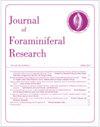暴露于Ph值和温度极端条件下的大型底栖有孔虫的壳溶解:来自原位实验的结果
IF 0.9
4区 地球科学
Q4 PALEONTOLOGY
引用次数: 22
摘要
富含二氧化碳的气体排放到浅海环境的地区可以作为研究二氧化碳浓度升高(即海洋酸化)对底栖生物群落的影响的天然实验室。巴布亚新几内亚Ambitle岛Tutum湾的热液喷口位于约10米深处,周围环绕着热带边缘珊瑚礁。研究人员从附近的珊瑚礁收集了7种大型底栖有孔虫的活体标本,将其放入小网袋中,并沿着温度(60-29°C)和pH(5.9-8.1)的梯度在6个不同的地点放置了5天。实验中使用了不同壳结构(瓷状与透明状)和组成(高镁和中镁方解石)的有孔虫物种。大约25%的标本,即7种中的4种,在60°C和pH低至6.2的温度下暴露5天,保持了正常的共生颜色,并表现出最小的溶解;在展开过程中失去共生体颜色的标本外壳显示出广泛的腐蚀。在温度约为40°C, pH值在5.9和7.4之间波动的环境中,超过80%的标本(每种至少代表一种)保持正常的共生颜色。这些观察结果表明,在pH值足够极端的条件下,只要有机物质基本上完好无损,居住在珊瑚礁上的有孔虫的壳就能有效地抵抗溶解,从而消除任何化石足迹。本文章由计算机程序翻译,如有差异,请以英文原文为准。
Shell Dissolution in Larger Benthic Foraminifers Exposed to Ph and Temperature Extremes: Results from an in Situ Experiment
Areas where CO 2 -enriched gases discharge into shallow-marine environments can serve as natural laboratories to study the effects of elevated p CO 2 (i.e., ocean acidification) on benthic communities. Hydrothermal vents in Tutum Bay, Ambitle Island, Papua New Guinea, occur at depths of ~10 m and are surrounded by a tropical fringing coral reef. Live specimens of seven species of larger benthic foraminifers were collected from a nearby reef location, placed in small mesh bags, and deployed for five days at six different sites along a gradient of temperature (60–29°C) and pH (5.9–8.1). Foraminiferal species that differ in shell structure (porcelaneous vs. hyaline) and composition (high- and intermediate-Mg calcite) were used in the experiment. Approximately 25% of the specimens, representing four of the seven species, retained normal symbiont color and exhibited minimal dissolution when exposed for five days to temperatures up to 60°C and pH as low as 6.2; shells of specimens that lost symbiont color during deployment exhibited extensive corrosion. More than 80% of the specimens, representing at least one of each species, retained normal symbiont color where the temperature was approximately 40°C and pH fluctuated between 5.9 and 7.4. These observations indicate that shells of reef-dwelling foraminifers can substantially resist dissolution, as long as organic matter is largely intact, under pH conditions sufficiently extreme to erase any fossil footprint.
求助全文
通过发布文献求助,成功后即可免费获取论文全文。
去求助
来源期刊
CiteScore
2.10
自引率
9.10%
发文量
32
审稿时长
>12 weeks
期刊介绍:
JFR publishes original papers of international interest dealing with the Foraminifera and allied groups of organisms. Review articles are encouraged.

 求助内容:
求助内容: 应助结果提醒方式:
应助结果提醒方式:


